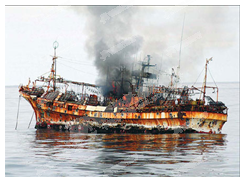The long, lonely voyage of the Japanese ghost ship is over.

A US Coast Guard cutter poured cannon fire into an abandoned Japanese ghost ship that had been drifting since last year’s tsunami, sinking the vessel into waters more than 305 meters deep in the Gulf of Alaska and removing the danger it posed to shipping and the coastline on Thursday.
The cutter’s guns tore holes in the 164-foot Ryou-Un Maru, and then it began to take on water and lean to one side. In about four hours, the ship disappeared into the sea, said Chief Petty Officer Kip Wadlow.
The ship had no lights or communications system, and its tank was able to carry more than 7,570 liters of diesel fuel. Officials, however, didn’t know exactly how much fuel was aboard.
“It’s less risky than it would be running into shore or running into other ships,” coast guard spokesman Paul Webb said.
The US National Oceanic and Atmospheric Administration and the Environmental Protection Agency studied the problem and decided it is safer to sink the ship than let the fuel evaporate and pollute the sea environment.
Ryou-Un Maru was probably among the first wave of the 1.5 million tons of garbage of refrigerators, washing machines, televisions, roofs and fishing nets heading toward North America since last March when a magnitude-9.0 earthquake struck Japan.
As the coast guard was ready to fire on the vessel, a Canadian fishing vessel, the 19-meter Bernice C, claimed the rights to save the ghost ship in international waters.
Plans to sink it were paused so the Canadian crew could have a chance to take the stricken ship. A Canadian official with knowledge of the situation told the Associated Press that the Bernice C was unable to drag it.
Then the Canadian boat left, and once it was about 10 kilometers from the Japanese vessel, the Coast Guard began to fire, first with 25 mm shells, then a few hours later with ammunition twice that size.
State officials have been working to test the danger of garbage including materials affected by a damaged nuclear power plant, to see if Alaska residents, seafood or wild animals could be affected.
小题1:Which of the following is NOT the reason for sinking the Japanese ship?
A.It had no lights or communications system.
B.It might be washed up onto the shore.
C.It was a danger to other passing ships.
D.The oil it carried could pollute the sea.小题2:The plan to fire on the Japanese ghost ship was paused because ____________.
A.the ghost ship was beyond the reach of the Coast Guard’s guns
B.the shells were not powerful enough to sink the ghost ship
C.state officials worried the ghost ship might give out radiation
D.a Canadian fishing boat wanted to save the ghost ship小题3:Which of the following could be the best title for the passage?
A.Japanese ghost ship arriving at US
B.Tsunami garbage heading to US
C.Cannon fire sinking Japanese ghost ship
D.Japanese ghost ship polluting the Pacific
小题1:A
小题2:D
小题3:C
题目分析:本文讲述地主要就是美国的 海军让这艘日本的船只沉没到海底的事件,分析了具体的原因。
小题1:A 推理题。根据文章第三段The ship had no lights or communications system这并不是原因,BCD三项都是让这艘船沉没的原因所在,故A正确。
小题2:D 细节题。根据文章倒数第三段A Canadian official with knowledge of the situation told the Associated Press that the Bernice C was unable to drag it. 说明D项正确。
小题3:C 主旨大意题。根据文章第一段A US Coast Guard cutter poured cannon fire into an abandoned Japanese ghost ship that had been drifting since last year’s tsunami, sinking the vessel into waters more than 305 meters deep in the Gulf of Alaska and removing the danger it posed to shipping and the coastline on Thursday.说明本文主要讲述的就是沉没这艘船只的话题,故C正确。
点评:本文讲述地主要就是美国的 海军让这艘日本的船只沉没到海底的事件,文章较难,要求考生在理解原文表面文字信息的基础上,做出一定判断和推论,从而得到文章的隐含意义和深层意义。推理题所涉及的内容可能是文中某一句话,也可是某几句话,但做题的指导思想都是以文字信息为依据,既不能做出在原文中找不到文字根据的推理,也不能根据表面文字信息做多步推理。
